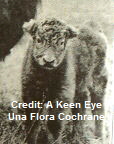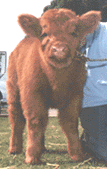


Crop Ear in Highland Cattle.
What is it and how does it look?
Crop ear can best be described as a cosmetic defect found in Highland Cattle. It can be as little as a very slight notch in the ears through to severe “cropping”.
Crop Ear creates a lot of discussion amongst Highland Breeders. Many, including ourselves, breed to exclude it while others see it as a minor fault.
Furthermore, some say that it is a sign of "purity" as it was believed that Crop Ear was not known in other breeds! Yet a research article published in 2013 quotes that it was present in other breeds of cattle... "Almost one hundred years ago, cattle showing crop ears were reported for the first time. Cattle with crop or notched ears show variably nicked ears sometimes combined with deformed ear cartilage and shortened pinnae. Isolated external ear anomalies are known in Scottish breeds such as Ayrshire and Highland cattle, and in Irish Dexter cattle" See the LINK to this excellent 2013 Research Article at the bottom of this page.
There is now a test that can be carried out by the University of Bern in Switzerland to determine whether an animal carries the Crop Ear gene. Crop Ear Test - University of Bern in Switzerland.
Highland Breed Societies differ in their approach to Crop Ear. Some allow registration of animals with crop ear while others will not allow registration of bulls with the defect.
Below are some photographs that demonstrate the visual effect that crop ear may take in some of its worst forms
Crop Eared Calves


NORMAL Ears

A study was carried out in Germany in 1991 on 548 Highlands on 108 farms. An abstract is published on the internet.
Dr. Glen Hastie, a vet and Highland Cattle breeder wrote an article for The Australian Highland Cattle Society Newsletter which explains the findings from that abstract.
Dr. Hastie kindly agreed that his article could be published on these web pages.
An Explanation of the Genetics of Crop Ear
by Dr. Glen Hastie BVSc MVS MACVSc, Bairnsley Highland Cattle.
This article is not meant to pass any judgement on whether Australia should or should not accept animals with crop ear into the Herd Book. It is purely a description of how the genes work to give rise to crop eared animals and to postulate some explanations as to discrepancies on the subject.
The important genetic facts in this explanation are taken from the scientific paper "Inheritance of Crop Ears in Highland Cattle by A. Scheider, P. Schmidt and O. Distl, Berl. Munch. Tierarztl. Wschr. 1994; 107: 348-352". The writers used information gathered from 548 stud book Highlands on 108 different farms in Germany.
General
This research has shown that this ear defect is inherited by a single autosomal dominant gene, however there is incomplete dominance. 'Autosomal' means not sex-linked and 'incomplete dominance' refers to the fact that animals with the gene will show varying degrees to which they are affected. Some will be so severe that the external ear is barely recognisable and some so mild that the notch at the tip of the ear is barely noticeable.
The nomenclature that will be used in this article is the standard nomenclature that is used in all genetics. In this article we will call the gene for crop ear 'C' and the small letter 'c' will be the gene for normal ears. All animals will have two genes for crop ear, one derived from their dam and one derived from their sire. This is the same as all autosomal genes.
Only animals with two genes for normal ears ('cc') will have normal ears. An animal with one or two genes for crop ear ('CC' or 'Cc') will have crop ear. This is the case with all dominant genes. Crop ear is dominant over normal ears.
The possible genetic combinations of animals:
CC
- these animals will have crop ear (the most severe form)
- these animals will pass the gene on for crop ear to their offspring —guaranteed. All of their calves should have some degree of crop ear.
- these animals MUST have received one dominant gene (C) from their sire and one from their dam. (i.e. both of their parents must have had crop ear).
Cc
- these animals should also have crop ear but these are the ones that account for the variation in severity. Some will be severe (although none quite as severe as CC animals) and some mild.
- these animals have a 50:50 chance of passing the dominant gene for crop ear (C) onto their offspring
- these animals must receive the dominant gene from one parent, and the recessive gene (c) from the other parent
cc
- these animals CAN NOT have crop ear. All animals in Australia should be like this.
- because these animals only carry the recessive gene 'c', they can not possibly give rise to an animal with crop ear when bred to each other.
An interesting way to look at it is with all the possible matings involving these genes.
Table of Genetic Combinations of Possible Matings and their Offspring
| CC | Cc | cc | |
|---|---|---|---|
| CC | 100% CC | 50% CC 50% Cc |
100% Cc |
| Cc | 50% CC 50% Cc |
25% CC 50% Cc 25% cc |
50% Cc 50% cc |
| cc | 100% Cc | 50% Cc 50% cc |
100% cc |
| CC bred with CC | all offspring should have crop ear - 100% of offspring will be CC (affected with severe crop ear) |
| CC bred with Cc | all offspring should have crop ear - 50% will be CC (severe crop ear) and 50% will be Cc (still crop ear but variable degrees) |
| CC bred with cc | all offspring should have crop ear - 100% will be Cc (variable degrees of crop ear, but none should be clear of it) |
| Ccbred with Cc | ¾ of offspring should have crop ear (25% CC, 50% Cc), and ¼ will be free of it (25% cc) |
| Cc bred with cc | ½ of offspring should have crop ear — 50% Cc (variable crop ear), 50% cc (no crop ear) |
| cc bred with cc | all offspring will be free of crop ear |
Facts we can derive:
- You should never get crop ear in a calf bred from two animals that are free of crop ear.
- If a calf is born with crop ear, then at least one of the parents MUST have had a gene for crop ear (‘C’).
As I have just said, a crop-eared calf must have at least one parent with at least one crop ear gene (Cc or CC). I am not saying that an animal with a crop ear gene will always have visible crop ear though. I think we can say that by far the majority of animals with a crop ear gene will have visually apparent or palpably apparent crop ear, but there are some circumstances where a calf will come from two apparently normal-eared animals.
Possible explanations for crop eared calves that come from supposed crop ear free animals include:
- One of the parents has mild crop ear (a very small notch) that was not detected. Highlands with very mild crop ear will not be picked up purely on a visual basis. You need to palpate the ears very carefully or even clip the ears to be sure.
- One parent has ears that are smaller than normal but they have no notches (this may be another variation of the Cc animals). This has been reported anecdotally to occur in animals that have crop-eared offspring.
- There is a very small percentage of animals with one gene for crop ear (Cc) that have normal ears (no notch and a normal size overall).
- Incorrect parentage identification. Meaning that the recorded parents are not the real parents of the calf.
- A mutation in the calf's genetic make up. This would be possible but would be an extremely rare event for any mutation.
Reference:
'Inheritance of Crop Ears in Highland Cattle' by A. Scheider, P. Schmidt and O. Distl, Berl. Munch. Tierarztl. Wschr. 1994; 107: 348-352
This concludes the article by Dr. Glen Hastie
....................................................................
For further reading the following Research Article was published in 2013.
A Non-Coding Genomic Duplication at the HMX1 Locus Is Associated with Crop Ears in Highland Cattle
Link to Article in PDF format.

